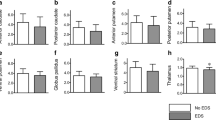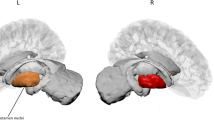Abstract
Introduction
Many patients with Parkinson's disease (PD) report daytime sleepiness. Its etiology, however, is still not fully understood. The aim of this study was to examine if the amount of nigrostriatal dopaminergic degeneration is associated with subjective daytime sleepiness in patients with PD.
Patients and methods
We investigated 21 patients with PD clinically and by means of [123I] FP-CIT-SPECT (DaTSCANR). Each patient filled in the Epworth sleepiness scale (ESS), the Parkinson's Disease Sleep Scale (PDSS), and the self-rating depression scale according to Zung (SDS) to assess sleepiness, sleep quality, and depressive symptoms.
Results
The mean specific dopamine transporter binding in the 21 PD patients (60.8 ± 10.4 years, nine females, median Hoehn and Yahr stage 2.0) was decreased. Nine patients were in Hoehn and Yahr stage 1 (58.7 ± 6.6 years, four females; ESS score 7.4 ± 4.5; PDSS score 105.1 ± 30.9), the other 12 patients were in Hoehn and Yahr stage 2 (62.4 ± 12.6 years, five females; ESS score 6.7 ± 4.7, PDSS score 97.1 ± 25.6). Age, gender, ESS, and PDSS scores were not significantly different in both groups. However, ESS scores showed an inverse correlation with mean DAT binding in the striatum (r = -0.627, p = 0.03), the caudate nucleus (r = -0.708, p = 0.01), and the putamen (r = -0.599, p = 0.04) in patients with Hoehn and Yahr stage 2. There was no correlation of the ESS score with age, disease duration, UPDRS motor score, PDSS score, or depression score.
Conclusion
Subjective daytime sleepiness seems to be associated with dopaminergic nigrostriatal degeneration in early PD.
Similar content being viewed by others
References
Lees AJ, Blackburn NA, Campbell VL (1988) The nighttime problems of Parkinson's disease. Clin Neuropharmacol 11:512–19
Abbott RD, Ross GW, White LR, Tanner CM, Masaki KH, Nelson JS, Curb JD, Petrovich H (2005) Excessive daytime sleepiness and subsequent development of Parkinson's disease. Neurology 65:1442–446
Frucht S, Rogers JD, Greene PE, Gordon MF, Fahn S (1999) Falling asleep at the wheel: motor vehicle mishaps in persons taking pramipexole and ropinirole. Neurology 52:1908–910
Happe S, Trenkwalder C (2005) Sleep disorders in Parkinson's disease. In: Ebadi M, Pfeiffer R (eds) Parkinson's disease. CRC Press LLC, Boca Raton, USA, pp 217–27
Ryan M, Slevin JD, Wells A (2000) Non-ergot dopamine agonist-induced sleep attacks. Pharmacotherapy 20:724–26
Happe S, Berger K (2001) The association of dopamine agonists with daytime sleepiness, sleep problems and quality of life in patients with Parkinson's disease. a prospective study. J Neurol 248:1062–067
Pal S, Bhattacharya KF, Agapito C, Chaudhuri KR (2001) A study of excessive daytime sleepiness and its clinical significance in three groups of Parkinson's disease patients taking pramipexole, cabergoline and levodopa mono and combination therapy. J Neural Transm 108:71–7
Arnulf I, Konofal E, Merino-Andreu M, Houeto JL, Mesnage V, Welter ML, Lacomblez L, Golmard JL, Derenne JP, Agid Y (2002) Parkinson's disease and sleepiness: an integral part of PD. Neurology 58:1019–024
Braak H, Rüb U, Gai WP, Del Tredici K (2003) Idiopathic Parkinson's disease: possible routes by which vulnerable neuronal types may be subject to neuroinvasion by an unknown pathogen. J Neural Transm 110:517–36
Del Tredici K, Rüb U, De Vos RA, Bohl JR, Braak H (2002) Where does Parkinson's disease pathology begin in the brain? Neuropathol Exp Neurol 61:413–26
Johns MW (1991) A new method for measuring daytime sleepiness: the Epworth sleepiness scale. Sleep 14:540–45
Gibb WR, Lees AJ (1988) The relevance of Lewy body to the pathogenesis of idiopathic Parkinson's disease. J Neurol Neurosurg Psychiatry 51:745–52
Hughes AJ, Daniel SE, Kilford L, Lees AJ (1992) Accuracy of clinical diagnosis of idiopathic Parkinson's disease: a clinico-pathological study of 100 cases. J Neurol Neurosurg Psychiatry 55:181–84
Hughes AJ, Daniel SE, Lees AJ (2001) Improved accuracy of clinical diagnosis of Lewy body Parkinson's disease. Neurology 57:1497–499
Hoehn MM, Yahr MD (1967) Parkinsonism; onset, progression and mortality. Neurology 17:427–67
Fahn S, Elton RL and members of the UPDRS development committee (1987) Unified Parkinson's disease rating scale. In: Fahn S, Marsden CD, Calne DB, Lieberman A (eds) Recent developments in Parkinson's disease. Florham Park, NJ: MacMillan Health Care Information, pp 153–63
Koch W, Radau PE, Hamann C, Tatsch K (2005) Clinical testing of an optimized software solution for an automated, observer-independent evaluation of dopamine transporter SPECT studies. J Nucl Med 46:1109–118
Chaudhuri KR, Pal S, DiMarco A, Whately-Smith C, Bridgman K, Mathew R, Pezzela FR, Forbes A, Högl B, Trenkwalder C (2002) The Parkinson's disease sleep scale: a new instrument for assessing sleep and nocturnal disability in Parkinson's disease. J Neurol Neurosurg Psychiatry 73:629–33
Zung WWK (1972) The depression status inventory: an adjunct to the selfrating depression scale. J Clin Psychol 28:539–43
Klawans HL, Goetz C, Nausieda PA, Weiner WJ (1977) Levodopa-induced dopamine receptor hypersensitivity. Trans Am Neurol Assoc 102:80–3
Kaasinen V, Aalto S, Någren K, Hietala J, Sonninen P, Rinne JO (2003) Extrastriatal dopamine D2 receptors in Parkinson's disease: a longitudinal study. J Neural Transm 110:591–01
Kaasinen V, Någren K, Hietala J, Oikonen V, Vilkman H, Farde L, Halldin C, Rinne JO (2000) Extrastriatal dopamine D2 and D3 receptors in early and advanced Parkinson's disease. Neurology 54:1482–484
Baier PC, Branisa P, Koch R, Schindehütte J, Paulus W, Trenkwalder S (2006) Circadian distribution of motoractivity in unilaterally 6-hydroxydopamine lesioned rats. Exp Brain Res 169:283–88
Eisensehr I, Linke R, Noachtar S, Schwarz J, Gildehaus FJ, Tatsch K (2000) Reduced striatal dopamine transporters in idiopathic rapid eye movement sleep behavior disorder. Comparison with Parkinson's disease and controls. Brain 123:1155–160
Eisensehr I, Linke R, Tatsch K, Kharraz B, Gildehaus JF, Wetter CT, Trenkwalder C, Schwarz J, Noachtar S (2003) Increased muscle activity during rapid eye movement sleep correlates with decrease of striatal presynaptic dopamine transporters. IPT and IBZM SPECT imaging in subclinical and clinically manifest idiopathic REM sleep behavior disorder, Parkinson's disease, and controls. Sleep 26:507–12
Benamer HT, Patterson J, Wyper DJ, Hadley DM, Macphee GJ, Grosset DG (2000) Correlation of Parkinson's disease severity and duration with 123IFP-CIT SPECT striatal uptake. Mov Disord 15:692–98
Tatsch K, Schwarz J, Mozley PD, Linke R, Pogarell O, Oertel WH, Fieber RS, Hahn K, Kung HF (1997) Relationship between clinical features of Parkinson's disease and presynaptic dopamine transporter binding assessed with [123I]IPT and single-photon emission tomography. Eur J Nucl Med 24:415–21
Rye DB (2006) Excessive daytime sleepiness and unintended sleep in Parkinson's disease. Curr Neurol Neurosci Rep 6:169–76
Romiti A, Brusa L, Marciani MG, Pierantozzi M, Placidi F, Izzi F, Sperli F, Testa F, Stanzione P (2005) Sleep episodes and daytime somnolence as result of individual susceptibility to different dopaminergic drugs in a PD patient: a polysomnographic study. J Neurol Sci 228:7–0
Author information
Authors and Affiliations
Corresponding author
Rights and permissions
About this article
Cite this article
Happe, S., Baier, P.C., Helmschmied, K. et al. Association of daytime sleepiness with nigrostriatal dopaminergic degeneration in early Parkinson's disease. J Neurol 254, 1037–1043 (2007). https://doi.org/10.1007/s00415-006-0483-6
Received:
Revised:
Accepted:
Published:
Issue Date:
DOI: https://doi.org/10.1007/s00415-006-0483-6




